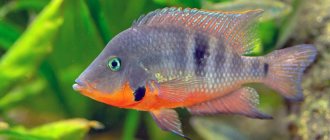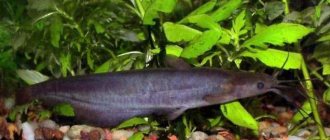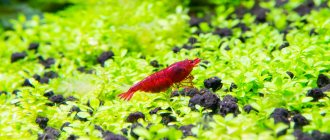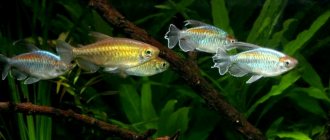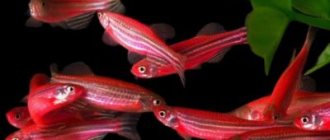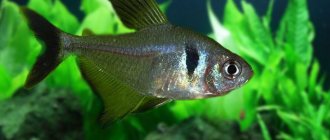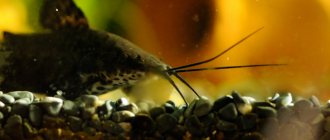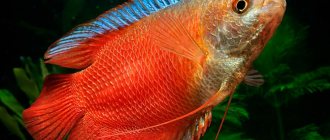These then little-known fish were brought for exchange. The boys called them semi-predators. The really strict striped color, swelling of the gill covers and spreading of the fins indicated that the black-striped cichlid fish were very serious. But those in the jar were still too small. And who can they offend? - I thought about it and agreed.
And in fact, the black-striped cichlids simply looked scary. They did not attack anyone, and increasingly stayed away in the lower part of the aquarium. But soon the black-striped cichlids grew up, paired up and began to defend their territory. This is where the black-striped cichlids began to show aggressiveness towards uninvited guests.
And if the small fish could quickly escape, the large ones did not have time and received a significant beating, the consequences of which were clearly visible in the form of red spots on the sides. But particular belligerence among black-striped cichlases manifested itself among males, where, as a rule, only the bravest and most aggressive one took the lead.
Description
Cichlazoma blackstripe belongs to the fish of the Cichlid family. The homeland of black-striped cichlases is Central America. In an aquarium, the black-striped cichlazoma grows 10 -14 cm, and lives under good conditions for up to 8 years. Males are usually larger than females and more colorful. The eggs are laid on a substrate (stone, pot, driftwood, etc.). The fry swim in 5-10 days (uncertainty is related to water temperature). Territorial, omnivorous fish.
The color of males and females is similar. The fish look like this: the head is dark in color, and on the light gray body, starting from the gill covers and up to the caudal fin, there are 8-9 vertical black stripes. Actually, this is where the name “black-striped cichlazoma” comes from. The fins of black-striped cichlases are quite developed, transparent and, with the exception of the pectoral and caudal fins, have pointed ends.
External characteristics
The body shape is a slightly oblong oval. Cichlazoma has a bright appearance: a large mouth in a downward position, large round black eyes with a golden border, a wide smooth forehead. The dorsal and anal fins stretch along the body, the outer rays (in the area of the tail) are pointed. The caudal fin is of harmonious size, without excesses.
The description of the colors of the black-striped cichlazoma currently includes several hybrid forms bred in captivity. The classic color is blue-gray with oblong black spots and transverse stripes. Due to the irregularity of the stripes, breaks and their bizarre shape, the fish are called “zebra cichlids”. Usually there are 8-9 stripes. The fins are transparent, with a barely noticeable yellow tint. Sometimes yellow-orange sparkles are possible on the fins and scales. In some individuals, the spots extend to the dorsal fin.
Feeding
When it comes to food, the black-striped cichlid is not at all picky. Black-striped cichlazoma does not refuse various dry foods: gammarus, daphnia and commercially produced feed. Among the vegetable ones, they do not refuse the crumbs of white bread, and among those prepared at home, they adore minced beef or pork heart.
Preparing such minced meat is not at all difficult: you need to cut off the fat, film and cartilaginous partitions from a beef or pork heart, then cut the heart into small pieces, put it in plastic bags and freeze. Before feeding, grate on a kitchen grater and feed in small portions. This minced meat is loved not only by the black-striped cichlid, but also by most fish.
But no matter what artificial food is, live food remains the most necessary and irreplaceable to this day. After all, only live food contains the amino acids necessary for the fish’s body, and only when feeding the fish with live food can the feeding be considered complete.
Among the live foods, the black-striped cichlazoma, like many fish, loves: bloodworms, coretra, tubifex and daphnia. But it is not always possible to get such food, so some aquarists breed live food at home.
Such food can be: grindal, enchytraeus, daphnia magna and moina. Of course, it won’t be possible to feed freely, and for large individuals such food will be too small, but for juveniles and small fish this is what they need.
Compatibility with other fish
Black-striped cichlazoma is compatible with all fish in a community aquarium before spawning. And during the breeding season, compatibility will depend on the size of the aquarium and the number of fish living in it.
It is possible to keep and even breed a pair of black-striped cichlases in a common aquarium, provided that the aquarium is elongated and free enough, only then the black-striped cichlases that have taken over the territory will not offend the fish living nearby.
The following fish are suitable for living together: swordtails, mollies, guppies, zebrafish, angelfish, gourami, barbs and many others. The recommended size of a general aquarium for keeping black-striped cichlases in it: 120x45x35.
Kinds
Like any other type of fish, cichlazomas have varieties:
Albino
This formulation assumes that the body of a fish (or any other creature) does not produce a coloring pigment at all. This is a genetic deviation that distinguishes fish from others of its species only by its external color. This does not affect behavior or condition. In nature and in artificial conditions, albinos are not uncommon. However, they have weaker immunity;
Flamingo
Some people believe that they are albinos, but this is not true. Many breeders consider flamingos to be a genetic mutation. Their pupil is black, while the albino body is not able to produce pigment and the eyes of such fish are red. In addition, the body of a flamingo can have different light shades, from pink to cream and even peach. Black-striped cichlasoma is an amazing fish. Its colorful appearance and aggressive behavior attracts the attention of hundreds of thousands of cichlid lovers. These are unpretentious aquarium fish, and this is what makes them so attractive.
Diseases
Black-striped cichlasoma prefers water temperatures from 24 to 28°C. When kept below 24° degrees, fish may develop ichthyophthyriasis. Signs of this disease: fish scratching on the ground and fins compressed. Also, a white coating in the form of small grains (semolina) appears on the body and fins.
The causative agent of the disease is an equiciliated ciliate parasitizing on the body of fish. Treatment is carried out both in a general and separate aquarium. For more information about fish diseases and the treatment of ichthyophthyriosis, see the publication “Treatment of aquarium fish with bicillin.”
Notes: An undesirable drop in temperature may not be the only cause of an outbreak of ichthyophthyriasis. It is known that the disease ichthyophthyriosis primarily affects fish with a weakened immune system, which can be caused by poor nutrition.
Mr. Tail Recommends: Aquarium Basics
Zebra cichlids are still extremely popular in modern aquarium hobby and are the leaders in the number of searches on the Internet.
These fish are the most unpretentious of the cichlid species and are quite small, but it is unlikely that beginning aquarists should breed them, since the requirements for the parameters of the aquatic environment must be strictly met. There are other rules for keeping these pets:
- The choice of tank should take into account the size of the pets. For a couple, 50-60 liters is enough, but it is better to keep these schooling underwater inhabitants in a small group in an artificial reservoir with a volume of at least 200-300 liters.
- It is best to choose a species aquarium in which to carry out proper zoning using vegetation, snags, grottoes, and caves. Blackstripes love secluded places; they also need a kind of “nursery” in which zealous parents will nurse their offspring.
- It is advisable to form the soil from granite chips or pebbles without sharp edges. Black-striped pets love to dig into the bottom filler and are able to raise clouds of turbidity from the soft substrate. Large stones are undesirable, as these natural builders will not be able to move them.
- Many grottoes and caves prepared in advance by the owner will help reduce the intensity of the Zebras’ construction activities and save the bottom from spontaneously appearing trenches and holes in places of aquatic plants. Blackstripes also love ceramic pots and halves of coconuts as houses.
- To preserve the original greenery of the tank, it is better to choose plant forms with strong roots and tough leaves. Echinodorus, cryptocoryne, and anubias are suitable. Vallisneria spiralis can be planted in the background in the form of dense thickets. This will create a beautiful decorative landscape and help purify the water from harmful substances and saturate it with oxygen.
- Algae of floating forms - riccia, pastia, wolfia - will shade the surface of the water and will serve to enrich the diet of pets with fresh plant components.
- The liquid for the reservoir should be prepared in advance. To do this, tap water is left to sit for at least 24 hours. Required parameters: temperature +24…+28 °C, hardness 9-28 dH, acidity 6-8.3 pH.
- If the tank is small and contains only one pair of Zebras, then their need for additional aeration and filtration is small, but in a large artificial reservoir these devices are necessary. In addition, sufficient flow should be provided; it is especially important for the proper development of the eggs.
- Every week you should replace about a third of the volume of water with clean, settled water.
- It is recommended to use overhead lighting, but for a more expressive play of color, you can occasionally turn on side or front lighting.
Reproduction
Reproduction of black-striped cichlids is very similar to the reproduction of parrot cichlids. The only difference is that parrot cichlids prefer to lay eggs only in shelters, while black-striped cichlids can lay eggs on open surfaces.
For masonry, you can place a small stone of a flat or semicircular shape on the bottom of the aquarium. The approximate size of the stone is 10x10x10 cm. The stone can be of any type; for example, I used flint. Black-striped cichlazomas, having reached sexual maturity, always willingly mate and spawn.
Shortly before spawning, black-striped cichlasomas carefully prepare the stone, cleaning its surface for laying eggs. After spawning, producers fan the clutches with fins, washing the eggs with running water. Required hydrochemical parameters of water for spawning: hardness 12°, acidity 7.2, temperature 28°C.
Notes: when I bred black stripes with cichlases, I never bothered about the hardness and acidity of the water. Although the water in my place of residence is hard—artesian—nevertheless, the spawnings were always successful. From literary sources it is known that one black-striped cichlasoma spawns up to 500 eggs, but I managed to raise about three hundred fry from one spawning.
After 3-5 days (depending on the water temperature), larvae begin to appear, which caring parents carefully collect in a pile and do not leave without attention for a second. To prevent parents from losing control over the larvae, and then the fry, it is impossible to turn off the light in the aquarium at this time. It is best to organize the spawning of black-striped cichlases in a separate aquarium, the size of which should not be less than 40x25x25 cm.
However, you should think in advance about the resettlement of the growing fry. Therefore, it is best if a separate aquarium for spawning black-striped cichlases is large enough and fulfills the task of not only a spawning tank, but also a nursery aquarium in the future.
in the photo cichlazoma black-striped caviar
During the incubation period, producers carefully care for the eggs, ensure cleanliness, and remove unfertilized and dead eggs.
After the larvae appear, the parents (female) move them to another secluded place, usually a corner of the aquarium with suitable shelter. After two to three days (when the yolk sac of the larvae disappears), the larvae emerge from the shelter and begin to swim under the close attention of their parents. To feed the young, the female, waving her fins, removes the turbidity from the bottom of the aquarium, and in the evening gathers everyone back into the shelter.
Starter feed
The best food for swimming fry is plankton: ciliates, rotifers, small daphnia. But you can get plankton in spring and summer, and even then only if the body of water in which it is found is known. A way out may be to breed live food at home.
For example, is Daphnia moina not an excellent food for swimming fry? Small moin nauplis will be the most valuable starter food at this time. In addition, over time, the grown fry can be fed with grown crustaceans. It is very profitable and convenient! It is not difficult to dilute moin. Read more in the publication “Food for Daphnia fish”. The second option for providing the fry with valuable starter food would be brine shrimp.
The only, but very significant drawback of Artemia crustaceans is that they live in demineralized water for only a short time, and the fry need constant nutrition. You can try to feed the fry with artificial food, for example, boiled yolk, as well as special food produced by industry, but the result of such food, believe me, is not at all pleasing.
Food for grown fry
Growing fry need to be switched to larger feeds. As I already wrote, Daphnia moina is a good choice for adolescent and juvenile fry. But over time, it is necessary to accustom the fish to artificial food, for example, minced beef or pork heart. This should be done gradually and in small portions 15-20 minutes before the next introduction of daphnia into the aquarium.
Over time, when you notice that the fish have begun to eat the new food willingly, then you can completely switch the fish to the new menu, not forgetting to include live food in the diet 2-3 times a week. In conclusion, it must be said that the black-striped cichlazoma is not a popular fish and they need to be bred in small quantities, so that later you don’t have to think about what to do with it.
Adviсe
- Place the aquarium with black-striped cichlids on a special stand. The volumetric tank is quite heavy to break a cabinet that is not strong enough.
- Gradually adapt the newly acquired black stripes to the conditions of your home pond. Place a bag of fish in a tank filled with water and let the temperatures equalize. After half an hour, gradually pour aquarium water into the bag in small portions.
- Make sure the plants have enough light. The flora, lacking light, dims and withers, growth is drawn in the direction of the light source. Replace the lamp with a more powerful one or install an additional light source.
- Do not buy food in bulk. Always look at the expiration date and read reviews about the manufacturers.
- Do not separate pairs of blackstripes or destroy their spawning areas. Cichlazomas do not form stable pairs throughout their lives and may refuse to spawn in the future with another partner. The spawning site often remains unchanged.
Black-striped cichlasoma is an aquarium inhabitant that remembers its breadwinner. Some aquarists tame the cichlid so that the fish allows itself to be petted and fed by hand. A cichlid can also bite if it doesn't like something.
Previous
Fish Artificially colored glass perch
Next
FishTOP 9 types of labyrinth fish
